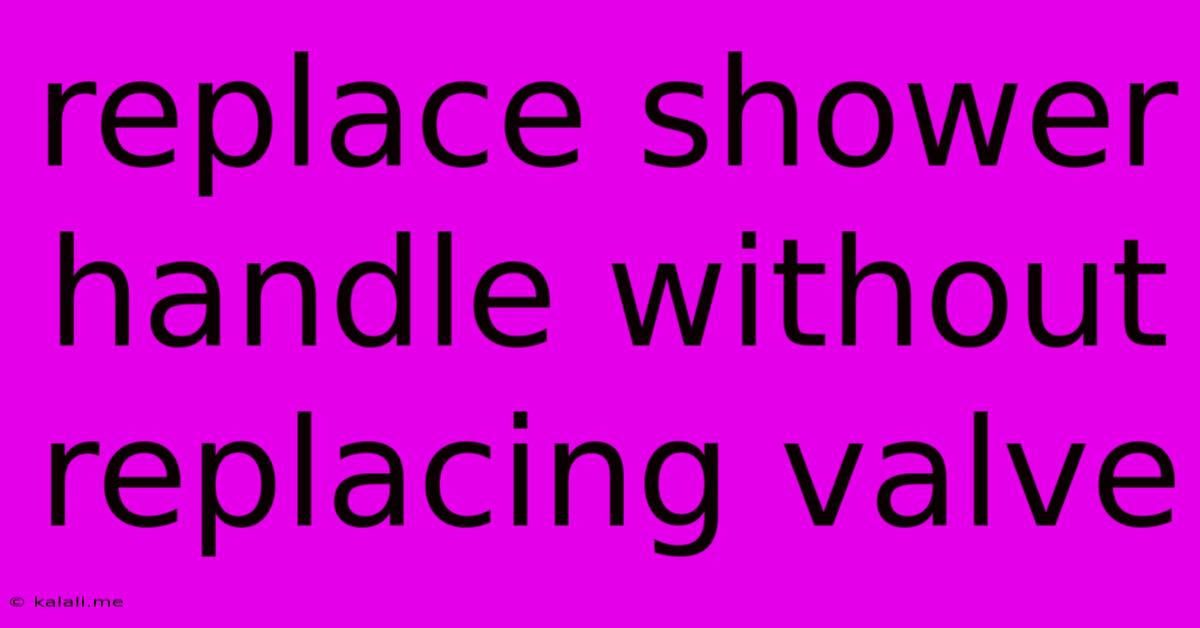Replace Shower Handle Without Replacing Valve
Kalali
Jun 09, 2025 · 4 min read

Table of Contents
Replacing a Shower Handle Without Replacing the Valve: A Step-by-Step Guide
Meta Description: Learn how to replace a leaky or broken shower handle without the hassle and expense of replacing the entire valve. This step-by-step guide provides clear instructions and helpful tips for a successful DIY repair.
Replacing a shower handle is a relatively simple plumbing task that can save you money and time compared to replacing the entire valve. This guide will walk you through the process, offering advice for various handle types and troubleshooting common issues. Before you begin, remember safety first! Turn off the water supply to the shower at the shutoff valves located behind the fixture. This is crucial to prevent water damage during the repair.
Tools You'll Need
Before starting, gather these essential tools:
- Screwdrivers: Phillips and flathead screwdrivers are commonly needed, depending on the handle type.
- Adjustable wrench: For tightening and loosening nuts or cartridges.
- Pliers: Channel-lock pliers might be useful for stubborn parts.
- Putty knife or scraper: To remove old caulking or sealant.
- Penetrating oil (optional): To loosen corroded parts.
- New shower handle: Ensure you purchase the correct replacement handle compatible with your existing valve. Take the old handle with you to the hardware store for easy matching.
- Plumber's tape (optional): For sealing threads.
- Cloth or rag: To clean up any mess.
Step-by-Step Instructions
The specific steps might vary slightly depending on your shower valve's brand and model. However, the general process is similar:
1. Remove the Handle:
- For screw-on handles: Look for small screws under the handle. Use a screwdriver to remove these screws. The handle should then easily pull off.
- For handles without visible screws: These often have a cap or cover that needs to be pried off gently using a putty knife or flathead screwdriver. Once the cover is removed, you might find screws underneath, or the handle may simply pull off.
2. Remove the Trim:
Once the handle is off, you might find a decorative trim plate. Remove this carefully, usually by unscrewing it or prying it off gently.
3. Accessing the Cartridge or Stem:
- Cartridge Valve: This type of valve uses a cartridge that you'll need to remove. This often requires unscrewing a retaining nut or clip, which might be visible once the trim is removed. Be careful to note the orientation of the cartridge before removing it to ensure proper reinstallation.
- Stem Valve: This uses a separate stem for hot and cold water control. You'll need to identify and remove these stems.
4. Replace the Cartridge or Stem:
- Cartridge Valve: With the old cartridge removed, lubricate the new cartridge's O-rings with silicone grease (if available) and carefully insert it into its place. Ensure it’s seated correctly before tightening the retaining nut.
- Stem Valve: Replace the old stems with the new ones, ensuring they are securely installed and aligned properly.
5. Reassemble:
Carefully reattach the trim plate, ensuring it is properly aligned. Then, replace the handle and tighten the screws.
6. Test and Seal:
Turn the water back on and test the new handle. Check for leaks around the handle and trim. If there are any leaks, retighten the connections. If the leak persists, you might need to replace the sealing washers within the cartridge or stem, or consider professional assistance. Apply fresh silicone caulking around the trim to seal the fixture against future leaks.
Troubleshooting Common Problems
- Handle won't turn: The cartridge or stem might be corroded or stuck. Apply penetrating oil and let it sit for a while before attempting to remove the parts. If the issue persists, you might need to carefully use pliers to loosen the parts.
- Leak after replacement: Ensure the new cartridge or stem is properly seated. Check the O-rings and washers for damage or wear, and replace them if necessary. Check also that the retaining nut or other fastening mechanisms are properly tightened.
Replacing a shower handle can be a satisfying DIY project. By carefully following these steps, you can usually complete the repair without needing to replace the entire valve, saving yourself time and money. Remember, if you encounter significant difficulties, it's always best to consult a qualified plumber.
Latest Posts
Latest Posts
-
What Kind Of Oil Does Subway Use
Jun 09, 2025
-
Can X Be Negative In Standard Form
Jun 09, 2025
-
What Do These Words Have In Common
Jun 09, 2025
-
How To Stick Whiteboard On Wall
Jun 09, 2025
-
Removing Wires From Push In Connectors
Jun 09, 2025
Related Post
Thank you for visiting our website which covers about Replace Shower Handle Without Replacing Valve . We hope the information provided has been useful to you. Feel free to contact us if you have any questions or need further assistance. See you next time and don't miss to bookmark.